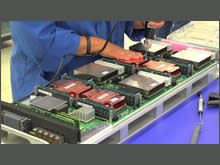Adaptive Computing demonstrates Moab HPC Suite - Enterprise Edition 8.1
Adaptive Computing, a long-time proponent of both technical and high performance computing and the Moab parallel processing open source project, recently announced version 8.1 of its Moab HPC Suite - Enterprise Edition. The goals were to improve overall scalability and manageability of the software. Furthermore, the company has worked to improve the performance in hybrid on- and off-premise computing environments. The company's software is being used in oil and gas geophysical research, financial analysis, manufacturing, research applications.
Quick analysis
Parallel processing monitors have been a mainstay of technical or high performance computing for decades. Clusters of computers, sometimes called matrix or grid computing, have been harnessed together to address very big and complex problems in architectural design, mechanical engineering, geophysical research, genetic research and many other areas.
What is a parallel processing monitor?
Must See Gallery
Six Clicks: The six fastest computers in the world
Parallel processing monitors are one of five different types of virtualization technology that are found at the virtual processing layer of virtualization technology (see Sorting out the different layers of virtualization for more information on the layers of virtualization). The goal of this type of processing virtualization technology is making it possible for many machines to execute the same applications or application components to sharply reduce the overall processing time of the application.
As a system completes a task, it asks the parallel processing monitor to give it something else to do. Each system then processes one segment of data or executes a single application component. As it finishes its task, the parallel processing monitor passes systems another task to complete. This computational approach allows applications to complete hundreds, thousands, or, perhaps, tens of thousands times faster.
Most parallel processing monitors have the ability to observe overall processing and allow administrators a great deal of control over what is processed, when it is processed and where the resulting data is stored.
This approach to processing virtualization has a side effect of increasing overall application availability. If a system fails while processing a unit of data or an application component, the parallel processing monitor detects the failure, marks that system as failed or unavailable, and then assigns the uncompleted work to the next available system that requests more work to do.
It's a simple concept, but the impact on technical or high performance computing is quite profound. The concept of big data analysis came out the use of this type of technology.
Moab faces strong competition
Adaptive Computing has made itself known in commercial, academic and governmental computing environments. The company has taken up the Moab open source project and is competing with other open source and commercial offerings.
Open source competitors include projects such as Avian, Rings, or Open MPI. Commercial competitors include IBM's Platform LSF, Open Parallel, and BoxCluster and Microsoft offers a HPC Pack for its Windows operating system.
This means that regardless of how good Moab is, Adaptive Computing faces challenges getting the attention of potential customers. What the company is doing, however, is certainly worth learning about if your organization is working in the areas of high performance or technical computing.



